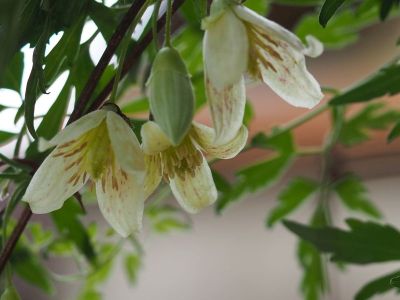

Design - High hopes: things are looking up - January 2019
Starting the New Year on a note of optimism, we say that we hope for things to look up, lift the spirits, raise our outlook. So it is with plants in the garden. For me, a garden that makes me feel up-lifted and inspired is often one where my eye is drawn skywards, where I have to look up.
I recall this sense of exhilaration particularly during a visit to the Villa Hanbury at Ventimiglia, near the French border. Do call in there if ever you are passing and experience the trees and shrubs soaring above the pathways leading down to the sea.

Exotic planting at Villa Hanbury: Russelia juncea cascading over a wall
Climbing plants can carry our thoughts to a higher level. Climbers that can cover walls, fences and pergolas or use living structures such as trees and shrubs for support will provide interest all year round. Some are particularly suited to our local climate and here are some suggestions - leaving roses aside for now.

Jasminum officianale
At the moment the Winter Jasmine (Jasminum nudiflorum) is in bloom with its acid yellow flowers; lovely scented white jasmine (Jasminum officianale) follows in June.

Clematis cirrhosa var balearica
This elegant fern-leaf clematis is in flower now. Next to my front door there is a Clematis cirrhosa var balearica which nods to me every time I go past. A species clematis native to Spain, it has small cream-white bells which are speckled inside. The foliage dies down in summer but returns in autumn. It needs no pruning other than a tidy if it is getting out of hand as it flowers on previous year’s growth. This family of clematis is resistant to heat, setting it apart from the large-flowered hybrids. A most welcome sight in these dark months.
Clematis for other times of the year: try Clematis viticella and Clematis flammula which are native to southern Europe and have small bell-shaped flowers.
I look forward to the Wisteria in spring. Some people warn against planting wisteria because it ‘takes over’, but not all wisterias are the same. There are two main groups:

Wisteria sinensis (Wikipedia)
Wisteria sinensis (Chinese Wisteria) is the really rampant one that can smother an entire house if you let it. I notice that it flowers best when grown over a garage – why? W. sinensis produces its flowers before the leaves appear and its stems twine clockwise (the direction when viewed from the base of the stem). Flowers are usually blue-lilac to mauve.

Wisteria floribunda ‘Rosea’
Wisteria floribunda (Japanese Wisteria) bears leaves and flowers at the same time and its stems twine anti-clockwise. Its long flower tresses show best on a pergola where they can hang down. This type is lot easier to keep ‘under control’. Colours range from white through pink to purple.
To view the largest collection of wisteria in Italy visit the gardens of Villa della Pergola near Alassio, Liguria in March-April.

Rosa banksiae lutea climbs over the roof of our cantina
In early spring it is hard to beat the exuberance of the Lady Banks’ rose which can cover an entire building.

Honeysuckle (Lonicera japonica)
There are several varieties of fragrant Honeysuckle (Lonicera) that we can enjoy in May-June. Native to woodland, they are happiest with shaded feet and heads in the sun.
Star Jasmine (Trachelospermum jasminoides) in found in almost every garden but nonetheless invaluable with its perfumed white flowers.
In summer the Campsis vine brings a show of colour; trumpet shaped flowers in hot orange and red shades. I like the yellow form ‘Flava’, which grows rampantly and can cover a shed in a season. At least it does in other people’s gardens but never in mine and I don’t know why not.

Passiflora caerulea
I once succumbed to a passionflower (Passiflora caerulea) but found it had straggly growth and self-seeded everywhere. Better behaved is Solanum (Solanum jasminoides), a relative of the potato with flowers in white or blue.

Abutilon megaponticum
And last but not least, in autumn Abutilon (Abutilon megaponticum) brings exotic ‘chinese lantern’ blooms.
So with all these to choose from why not get some climbing plants going in your garden: you may find that things - and you - will start to look up.
The photo at the top of this page shows Wisteria floribunda ‘Rosea’ on my pergola which grows quite slowly
Many of these articles first appeared in the Castiglione del Lago monthly newsletter “Qua e là” edited by Priscilla Worsley
All text and photographs © Yvonne Barton unless stated otherwise